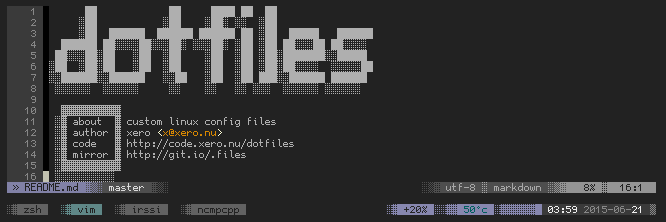blog.x-e.ro / tutorial: page 1 of 16
notes :: chatters cheatsheet
when i first wrote this document, nearly a decade ago, it was a gist i used as an operator cheatsheet. well, at this point it's somehow on the top of the google search results for "irc reference", so i decided to revisit the document and embellish it with the regular user side of irc as well.
the gist
this is my arch linux install guide. it's not meant to replace the beginners guide or the install guide, but act as a quick overview of exactly what the install process entails. hopefully this will encourage those intimidated by the terminal only install process.
this setup is for my HP Envy 6t-1000 laptop. it has a 32gb ssd drive with two partitions for boot and / and the other 500gb hdd is my home. my laptop has plenty of ram so i do not use a swap. my laptop also has UEFI bios and will cover it's install procedure.
boot to the install medium and you will be greeted by the prompt:
root@archiso ~ #
 in the unix world programs are commonly configured in two different ways, via shell arguments or text based configuration files. programs with many options like text editors are configured on a per-user basis with files in your home directory ~. in unix like operating systems any file or directory name that starts with a period or full stop character is considered hidden, and in a default view will not be displayed. thus the name dotfiles.
in the unix world programs are commonly configured in two different ways, via shell arguments or text based configuration files. programs with many options like text editors are configured on a per-user basis with files in your home directory ~. in unix like operating systems any file or directory name that starts with a period or full stop character is considered hidden, and in a default view will not be displayed. thus the name dotfiles.
it's been said of every console user:
you are your dotfiles
ok, i said that ;P
since they dictate how your system will look and function.
i manage mine with gnu stow, a free, portable, lightweight symlink farm manager. this allows me to keep a versioned directory of all my config files that are virtually linked into place via a single command....
linux :: running github's open source text editor
update: this post is outdated & atom sux

atom is a "hackable text editor for the 21st century" created by the team at github. it's designed to be customizable, but also usable without needing to edit a config file.
because we spend most of our day in a text editor, the single most important feature we wanted in an editor was extensibility. atom is built with the same open source technologies used by modern web browsers. at the core of atom is chromium, the open source project behind google chrome. with that comes all the power and innovation being developed for the web. but more importantly, extending atom is as simple as writing javascript and css, two languages used by millions of developers each day.
atom.io
code :: source code management with git

git is a distributed revision control and source code management (SCM) system with an emphasis on speed. git was designed by linus torvalds, of linux fame, for managing the development of the kernel. every git working directory is a fully fledged repository, complete with revision tracking abilities independent of a network or centralized server. git is 100% open-source, freeware, and distributed under the GNU general public license v2.
sql :: quick and dirty sql example
sometimes you find the need to do mass string replacements in your mysql/maria databases. here's how i do it:
UPDATE your_table
SET your_field = REPLACE(your_field, 'old_value', 'new_value')
WHERE your_field LIKE '%old_value%'
misc :: steamed and fried goodness

one day i walked into an unfamiliar chinese restaurant and ordered szechuan tofu. the nice lady behind the counter asked me if i wanted it steamed, fried... or both. at that moment my mind was blown. and the idea of double cooked tofu was born. it’s a simple recipe for anyone new to cooking tofu. this article is meant to teach you how to cook tofu, not flavor it. tofu is known for taking on the tastes of whatever it’s cooked with. after cooking the tofu in this method you can coat or sauté it in a sauce of your choice, or eat it plain.
 in the unix world programs are commonly configured in two different ways, via shell arguments or text based configuration files. programs with many options like text editors are configured on a per-user basis with files in your home directory ~. in unix like operating systems any file or directory name that starts with a period or full stop character is considered hidden, and in a default view will not be displayed. thus the name dotfiles.
in the unix world programs are commonly configured in two different ways, via shell arguments or text based configuration files. programs with many options like text editors are configured on a per-user basis with files in your home directory ~. in unix like operating systems any file or directory name that starts with a period or full stop character is considered hidden, and in a default view will not be displayed. thus the name dotfiles.


